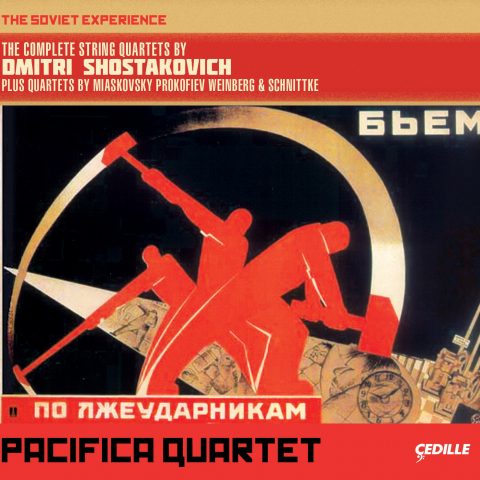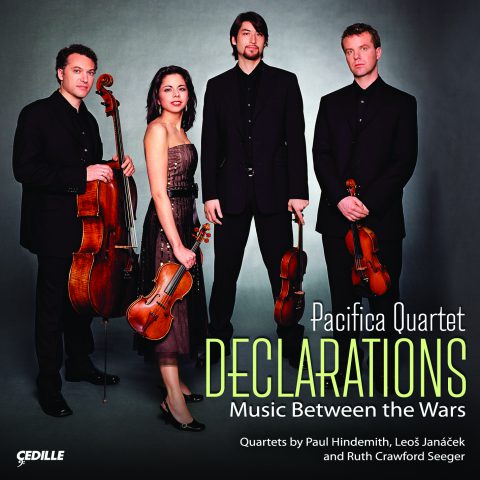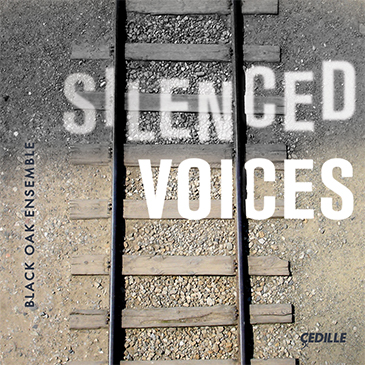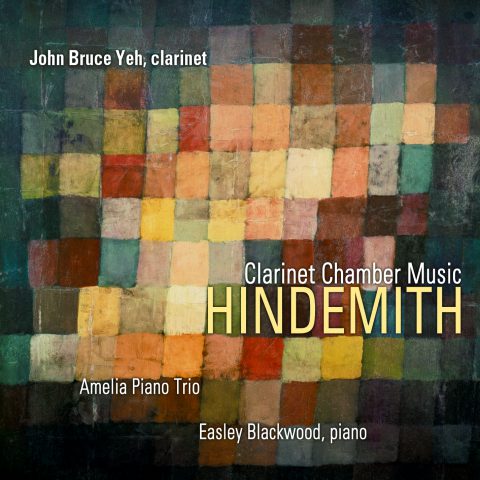| Subtotal | $18.00 |
|---|---|
| Tax | $1.85 |
| Total | $19.85 |
Store
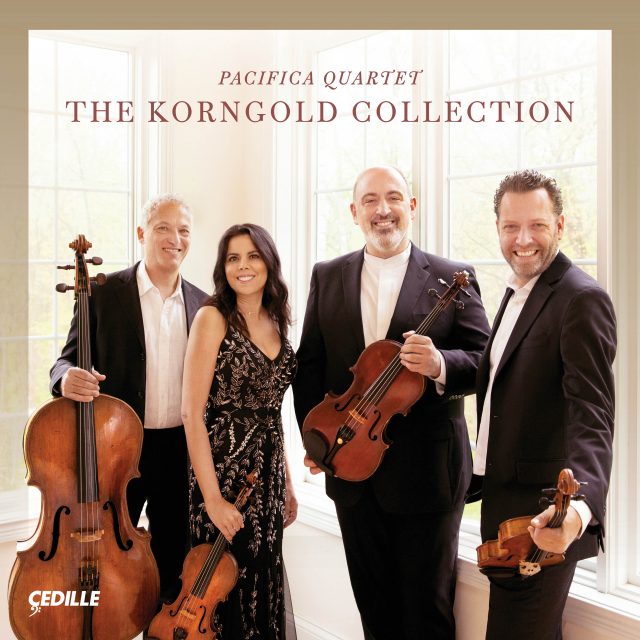
The Pacifica Quartet presents The Korngold Collection, a landmark recording of Erich Wolfgang Korngold’s complete string quartets and rarely heard chamber works tracing the composer’s extraordinary evolution from prodigy of post-imperial Vienna to pioneering film composer in Hollywood.
Described by The Daily Telegraph as “nothing short of phenomenal,” the multiple Grammy Award–winning Pacifica Quartet brings more than three decades of acclaimed artistry to this sweeping portrait of Korngold’s chamber music.
The three string quartets, written between 1923 and 1945, chart Korngold’s artistic journey: the First Quartet pulses with adventurous harmony; the Second, composed just before his emigration from Austria, overflows with lush melody; and the Third, finalized after WWII, draws on themes from his iconic film scores, including The Sea Hawk and Between Two Worlds.
Complementing the quartets are two early chamber gems: the radiant Piano Quintet in E major (1920), written in the wake of his operatic triumph, Die tote Stadt and performed with pianist Orion Weiss; and the vibrant String Sextet in D major (1914), a youthful work that helped establish Korngold’s early reputation, featuring violist Milena Pájaro-van de Stadt and cellist Eric Kim.
Praised for their “remarkable expressive range and tonal beauty” (The New York Times), the Pacifica Quartet has distinguished itself through a deep commitment to complete composer cycles, including The Soviet Experience, their celebrated survey of Shostakovich’s 15 string quartets, plus quartets by his contemporaries.
The Korngold Collection was produced and engineered by Judith Sherman and Bill Maylone. The album was recorded on May 11–12 and August 24–25, 2024, and May 27–30, 2025, in Auer Hall at Indiana University, Bloomington.
The Korngold Collection is made possible by the generous support of Eva Lichtenberg and Arnold Tobin.
Preview Excerpts
ERICH WOLFGANG KORNGOLD (1897–1957)
String Quartet No. 1 in A Major, Op. 16
String Quartet No. 2 in E flat major, Op. 26
String Quartet No. 3 in D major, Op. 34
Artists
1: Pacifica Quartet
Program Notes
Download Album BookletProgram Notes
Notes by Ben Winters
Erich Wolfgang Korngold (1897–1957) was born in what is now the Czech Republic and raised in Vienna as the son of one of the city’s leading music critics. A child prodigy, he was proclaimed a genius by Gustav Mahler. By the time he was in his early 20s, he enjoyed a prominent career in the concert halls and opera houses of Europe and America. Korngold subsequently found a new audience in the 1930s as a composer for Hollywood films, and in his later compositions found ways to bring these two often separated arenas of cultural life into productive dialogue (e.g., in his 1945 Violin Concerto).
The works presented here span virtually Korngold’s entire career as a composer of instrumental chamber music and reveal many of the qualities associated with his larger-scale output. The teenaged composer worked on his ambitious new String Sextet in 1914 alongside Violanta, one of two one-act operas whose first performances, in March 1916, would create an international sensation and launch Korngold on the path to operatic superstardom. It was not until May 2, 1917, though, that the Rosé Quartet, augmented by violist Franz Jellinek and cellist Franz Klein, gave the Sextet its first performance. After a rather spiky opening, the first movement settles into warm D-major melodiousness redolent of Brahms, though ghostly passages of parallel fourths in the middle of the movement reveal Korngold’s inherent grasp of the dramatic. A serious and somewhat Mahlerian Adagio is followed by an F-major Intermezzo, whose Viennese character was highlighted by contemporary critics. Der Morgen’s reviewer heard in it a place “where elves, gnomes and other good and evil spirits of the Vienna Woods twirl in undulating waltz rhythms.” The Sextet ends with a return to D major and one of Korngold’s most joyous finales, with players instructed to play “as fast as possible with fire and humor.”
Critic Josef Reitler noted how Korngold tended to turn to chamber music after his stage works, and in the aftermath of the worldwide success of his opera Die tote Stadt, premiered in December 1920, Korngold did just that. The Piano Quintet and String Quartet No. 1 date from the years immediately following, with the Quintet given first in Hamburg on February 16, 1923, and then in Vienna on March 1 in a performance featuring the composer at the piano alongside the Mairecker-Buxbaum Quartet. The opening E-major movement revels in the complexity of Korngold’s youthful harmonic language, albeit with the lyricism of his operatic writing also much in evidence. Reitler was suitably enthusiastic in his review, noting, “even as the boldly sweeping main theme begins with enthusiastic gestures, one has the unmistakable feeling: Korngold!” Critic Heinrich Kralik astutely drew his readers’ attention to the connections between the work and Korngold’s recent set of songs, Vier Lieder des Abschieds, which provided the material for the Quintet’s central movement and speak of Korngold’s blossoming romance with Luise (Luzi) von Sonnenthal — whom he would marry on April 30, 1924, after much objection from Korngold’s parents. This Adagio consists of a set of nine free variations on an eight-bar theme, drawn largely from the third of the Abschiedslieder, “Mond, so gehst du wieder auf,” and incorporates some luminous string harmonics in the final, ninth variation. The Quintet’s finale, introduced by unison declaration and a dramatic violin cadenza, is a typically good-natured affair full of offkilter metrical complexities.
Critic Elsa Bienenfeld described the String Quartet No. 1, which Korngold dedicated to the Rosé Quartet (who gave the first performance in Vienna on January 8, 1924), as a joyful piece. “The writing,” she said, “is short, concise, full of movement, nimble, with bold rhythms: full of life.” Bienenfeld claimed that a new work by Korngold was by now a significant musical event akin to a new opera by Richard Strauss or Puccini, and the complexities of the Allegro molto first movement suggest a piece of great skill and serious purpose. The passionate intensity of the song-like Adagio quasi Fantasia contrasts with the graceful Intermezzo, which makes use of a typical Korngold melody that would find further use in varied forms in later years. The opening melody of the Allegretto amabile e comodo finale, which uses the intervals of the composer’s personal motto theme (the “motif of the cheerful heart,” comprised of two interlocking, rising fourths plus a rising fifth), likewise found a new home in the 1930s in Korngold’s last opera, Die Kathrin, in a rare instance of instrumental music being recast in a vocal context. (Usually, for Korngold, the process went in the other direction.) The movement is prefaced by a Shakespeare quotation from As You Like It (“When birds do sing, Hey ding a ding, ding. Sweet lovers love the spring.”), and its intrinsically dramatic character is suggested by the imaginative use of atmospheric string effects and a charming, martial second subject.
If Korngold’s star was very much in the ascendant in 1924, a decade later it had arguably peaked. His fourth opera, Das Wunder der Heliane (1927), had not been welcomed by critics or the public with the same enthusiasm as Die tote Stadt. Korngold had, perhaps as a consequence, become increasingly drawn to the world of arranging Viennese operetta in collaboration with theatre director Max Reinhardt — an association that would shortly lead him further away from concert and operatic life to exciting opportunities as a composer of film scores in Hollywood. Written in 1933, the String Quartet No. 2 was premiered in Vienna by the everfaithful Rosé Quartet on March 16, 1934, and is characterized by a simpler harmonic language that points to the musical world in which Korngold had recently immersed himself. Indeed, critic Paul Stefan suspected a new and cheerful stage work might be imminent, such was the good humor evident in the opening E-flat major Allegro and the following Intermezzo, which recalls Korngold’s earlier incidental music to Shakespeare’s Much Ado About Nothing. The Larghetto movement’s opening (actually marked Lento) showcases Korngold’s ongoing fondness for mysterious sounding string harmonics before opening out into a rich, deeply felt cantilena melody. Stefan compared the waltz finale with Ravel’s La Valse, but it was the composer’s “captivating lyricism” to which the critic attributed the work’s success.
In October 1934, Korngold accepted an invitation to arrange Mendelssohn’s music for Reinhardt’s film version of A Midsummer Night’s Dream, thus beginning his 12-year career as a composer for Hollywood — almost exclusively for the Warner Bros. studio. Korngold’s activities in Hollywood helped elevate the art of film scoring to new heights. It also saved both his life and those of his extended Jewish family when the Nazi Anschluss of Austria occurred in 1938. During these war years he essentially gave up composing for the concert hall — until Christmas 1944, when Korngold presented his wife Luzi with bound sketches for a new work: his third string quartet. He finished the composition the following summer. It was long thought to have been first performed by the Roth Quartet in 1946, but Korngold researcher Troy Dixon has established a revised premiere date of January 3, 1949, in Los Angeles by the New Art Quartet. Korngold’s final work in this genre makes use of his film themes in three out of its four movements, the rather acerbic and chromatically rich opening Allegro moderato being the exception. The musical language of this first movement appears to return to the Korngold of the 1920s, as does the angular scherzo that follows, which seems a cousin of the Groteske of his Op. 23 Suite (1928–1930). The scherzo’s trio section, however, shifts to E major and a diatonic theme associated with a kindly character from Between Two Worlds, a score Korngold wrote between December 1943 and March 1944. The third and fourth movements are even more dependent on film-score content: Sostenuto. Like a Folk Tune is based on music for a love scene from The Sea Wolf (1941) while the quicksilver Allegro con fuoco finale uses themes written for the Brontë sisters biopic Devotion, on which Korngold had worked from 1942 to 1943. The String Quartet No. 3 remained Korngold’s final word in the arena of instrumental chamber music. In drawing upon material from his film scores, it set the pattern for his remaining concert works to follow.
Dr. Ben Winters is Senior Lecturer in Music at
The Open University, UK, and has published
widely on the music of Korngold. His most recent
book is Korngold in America: Music, Myth, and
Hollywood (Oxford University Press, 2025).
Notes by
Album Details
Producer Judith Sherman
Engineer Bill Maylone
Engineer (String Quartet No. 3 and Piano Quintet) Konrad Strauss
Recorded
May 11–13, 2024 (String Quartet No. 3 and Piano Quintet);
August 24–25, 2024 (Sextet); and
May 27–30, 2025 (String Quartets Nos. 1 & 2)
Auer Hall, Indiana University, Bloomington
Cover Photo Lisa-Marie Mazzucco
Graphic Design Bark Design
CDR 90000 240
